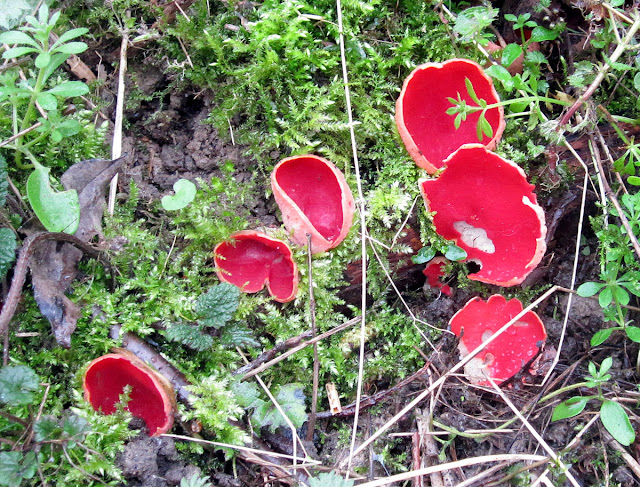 |
| View from Scord's Wood, 3 March 2012. |
On another rainy and drizzly day the Orpington Field Club walked some of the trails around Toys Hill, looking in particular for mosses and liverworts.
We saw quite a few. I had seen some of the mosses before, but I was surprised by all the different liverworts, which are so inconspicuous and moss-like that I have probably seen them many times without realising it. I will put about a dozen moss and liverwort photos, as well as these and other photos from the walk, in this folder if anyone wants to see them all:
Toys Hill photos.
Here is a sample.
 |
| Atrichum undulatum. Toys Hill, 3 March 2012. |
This is one of a group of mosses that grow in clumps with a robust and starry appearance. Some, the Polytrichums, have opaque leaves and have hairy caps over the young spore capsules; these have translucent wavy leaves and hairless caps.
 |
| Mnium hornum with capsules. Toys Hill, 3 March 2012. |
Mnium hornum is a common moss. This clump is full of spore capsules.
 |
| Diplophyllum albicans, a leafy liverwort. Toys Hill, 3 March 2012. |
Some liverworts have flat lobes, and some are leafy, like this one, and hard to tell from mosses when they have no spore capsules. When they do, you can see that the capsules are rounded and dark brown or black, and the setae that bear them are fragile and temporary.
 |
| Lophocolea species. A liverwort that smells of disinfectant. Toys Hill, 3 March 2012. |
This Lophocolea is spreading over a tree stump, and you can see some of the round capsules and whitish setae. This one is also unlike a moss in that if you drag a fingernail over it, it smells strongly of disinfectant.
We also saw some fungi, including one I had not seen before:
 |
| Bitter Oysterling, Panellus stipticus. Toys Hill, 3 March 2012. |
This fungus was supposedly once used to stem the flow of blood. We also saw many more of the
Scarlet Elfcups that I first saw back in February; some of these were noticeably larger, as much as 5cm across.
 |
| Scarlet Elf-cup, Sarcoscypha coccinea. Scord's Wood, 3 March 2012. |
I would not want you to think that we only saw mosses, liverworts and fungi. The woods were full of new growth. There were hillsides covered with bluebells, but only a few scattered plants were in flower. Primroses flowered by the paths, and there were small specimens of the so-called Golden Saxifrage in many places. I didn't get decent photos of any of them. There were ferns, including this one, which was on a clay bank:
 |
| Hard Fern, Blechnum spicant. Toys Hill, 3 March 2012. |
Its fronds are branched once, with simple pinnae, unlike many of our ferns which are branched twice or three times. And Hazel catkins were abundant. The tree in the centre of the top photo is full of them. On the way back we passed an old water tower, which has been converted into a bat tower. There is a superb echo if you hoot into the doorway, and few could resist having a go.
 |
| Investigating the echo in the Bat Tower. Toys Hill, 3 March 2012. |
As we approached the car park, the sun came out! But once again, because of the rain I didn't take my big camera. I wished I had it for a lot of these closeups. The two scenic views were taken with my iPhone, and the rest with my Ixus 100.









No comments:
Post a Comment